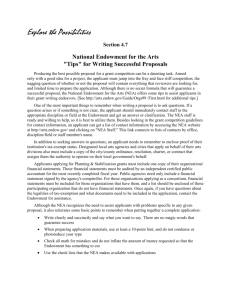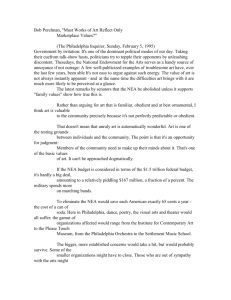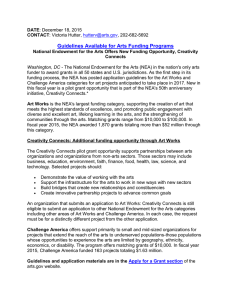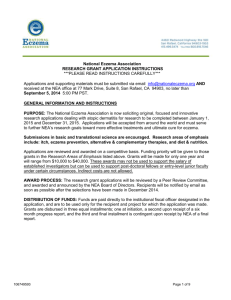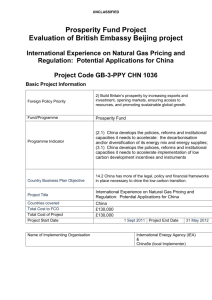Barb Ehlers
advertisement
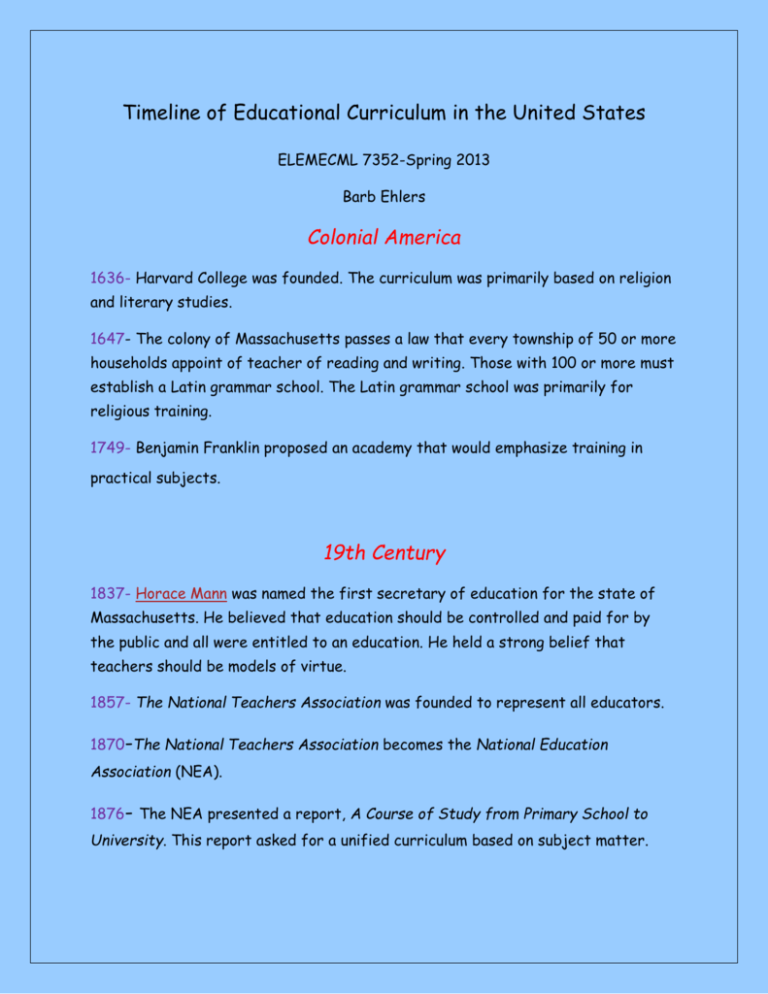
Timeline of Educational Curriculum in the United States ELEMECML 7352-Spring 2013 Barb Ehlers Colonial America 1636- Harvard College was founded. The curriculum was primarily based on religion and literary studies. 1647- The colony of Massachusetts passes a law that every township of 50 or more households appoint of teacher of reading and writing. Those with 100 or more must establish a Latin grammar school. The Latin grammar school was primarily for religious training. 1749- Benjamin Franklin proposed an academy that would emphasize training in practical subjects.1 19th Century 1837- Horace Mann was named the first secretary of education for the state of Massachusetts. He believed that education should be controlled and paid for by the public and all were entitled to an education. He held a strong belief that teachers should be models of virtue. 1857- The National Teachers Association was founded to represent all educators. 1870-The National Teachers Association becomes the National Education Association (NEA). 1876- The NEA presented a report, A Course of Study from Primary School to University. This report asked for a unified curriculum based on subject matter. 1893- NEA issues: Report of the Committee of Ten on Secondary Schools. The report recommended subjects and time allotments for high schools. The primary purpose was preparation for college. 1895- A group of Herbartians, The Committee of Fifteen, proposed an elementary school curriculum which was child-centered and included subjects for their social usefulness. 1879-John Dewey began his career as an educator. His influence on education including progressive education and a focus on experience in education is still felt today. 20th Century and Beyond 1918-NEA appointed a commission to examine the curriculum of secondary schools. The Cardinal Principles of Secondary Education was published as a federal bulletin. This bulletin focused secondary school curriculum on life’s experiences, not just subject matter. They developed seven objectives of education: 1. Health 2. Command of fundamental processes 3. Worthy home membership 4. Vocation 5. Citizenship 6. Worthy use of leisure 7. Ethical Character 1918-The Curriculum, by J. Franklin Bobbitt, was published; the first book to focus on curriculum principles and procedures. 1923- Curriculum Construction, by W.W. Charter introduced “activity analysis” linking the curriculum directly to society. 1923-1952-Jean Piaget researches and develops his four stages of cognitive development. These stages influenced curriculum a great in focusing on individual development and the dependence on constructivist experiences in education. 1924- How to Make a Curriculum (Bobbitt) explains procedures to guide selections of activities of daily living for school programs. 1927- National Society for the Study of Education (NSSE), published the 1927 NSSE Yearbook which delineated eighteen central questions as the foundation on which curriculum decisions are based. The questions included all three aspects of curriculum; subject matter, society, and individuals. 1930- The Progressive Education Association undertakes the Eight-Year Study to determine the effect of traditional high school curriculum design and experimental curriculum design on the success of those students in college. The study showed that those students who experienced a curriculum developed by the students and their teachers showed a slight academic advantage and were better off in their personal lives. 1942- The Eight-Year Study was published and largely ignored due to the preoccupation of the United States in World War II. 1949- The results of the Eight-Year Study did influence professional development curriculum workshops. The Basic Principles of Curriculum and Instruction by Ralph Tyler was influential in curriculum planning following World War II and is still wellrespected today. 1940’s-1950’s- As a result of the war, Americans again believed that education should be more society-centered and less individual-centered. 1957- The Russians launched Sputnik, the first satellite to orbit the earth. The United States viewed this as a threat to our nation’s security and blamed a weak educational system. 1960- The Process of Education, by Jerome Bruner is published. He viewed children as active problem solvers ready to tackle difficult subjects. He coined the term, “spiraled curriculum” in which topics are approached at different levels during a child’s education. 1960’s- The Curriculum Reform Movement led to federally-funded workshops (mostly science and math) to acquaint teachers with curriculum materials with directions for teachers and students to ensure quality education. Success was limited except when teachers modified the curriculum to suit the students in their classrooms. 1960’s- Most Americans viewed education as imperative for success in life. The general mood of the country was influenced by the Viet Nam War and the promise by the Johnson administration to end poverty through education. Once again the pendulum seemed to swing toward a common curriculum. 1970’s- Accountability of teachers in regard to students’ test scores led to a narrowing of the curriculum to that which was easily testable. 1980’s- 700 national reports on the state of American education were prepared. 1983- The National Commission on Excellence in Education report, A Nation at Risk: The Imperative for Educational Reform, declared the malaise of the school system that could be remedied by curricular improvement. The first recommendation for high school requirements was no different than previous requirements. Other recommendations included more rigor, measureable standards, more time, and improving salaries and working conditions for teachers. Ironically, it also included no funding from the federal government to implement the recommendations. 1990’s-As a classroom teacher during this time, I constantly heard we needed to improve education, but was never given clear guidelines in how to do so. 2001-No Child Left Behind Act passed by Congress and signed into law in 2002. The act endorses emphasis on a few academic subjects, more time teaching them, and testing students more often. Schools that do not make annual yearly progress are first given funding to improve, then if unsuccessful, are run by the state or dissolved. 2010-2011- The Common Core Standards for math and language arts are adopted by a majority of states. Previously, states had spent a lot of time developing local and state standards and benchmarks, but finally, a national common core curriculum is developed and adopted. The standards are broad statements declaring what students should know, understand, and be able to do at specific grade levels. This standards-based movement gives teachers a basis for curriculum planning, but allows for differentiation in delivery that can be modified for their students.


